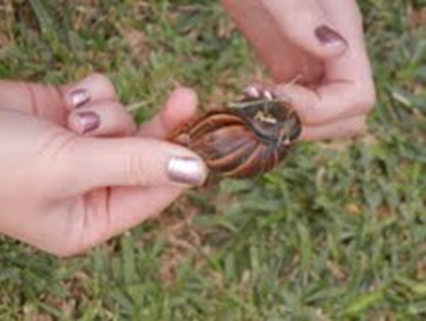Adaptation
Terrestrial snails such as Inflectarius kalmianus species are usually nocturnal, unless a rainstorm providing high moisture levels lead them otherwise (Burch, 1962). Their nocturnal habits are due to the presence of their preferred temperature and moisture levels (Burch, 1962). During the day they're usually found in areas that provide the most moisture such as under rock piles and logs (Burch, 1962).
Snails are more adaptive to unfavorable environmental conditions such as droughts because they have adapted the ability to fill the aperture (the opening) of their shell with a mucous sheet that soon hardens and protects them from drying out (Burch, 1962).
 This
image of a terrestrial
snail species was taken in Hawaii to show the mucous
layer in the aperture of the snail that’s used to
keep the moisture in to prevent from drying out
(Burch, 1962). You can also see the hard shell that
these gastropods have to protect themselves from
predators and harsh conditions in their environment.
Their ability to go days without food or water make
it easy to live in open areas because if necessary,
they can hide out in their shell until it rains or
some form of moisture emerges (Burch, 1962). Snails
usually go into hiding during the winter, usually
under logs or buried underground (Burch, 1962). But
since they can adapt to these changes, they can also
stick it out through the unfavorable temperatures
and stay in open areas such as on trees (Burch,
1962).
This
image of a terrestrial
snail species was taken in Hawaii to show the mucous
layer in the aperture of the snail that’s used to
keep the moisture in to prevent from drying out
(Burch, 1962). You can also see the hard shell that
these gastropods have to protect themselves from
predators and harsh conditions in their environment.
Their ability to go days without food or water make
it easy to live in open areas because if necessary,
they can hide out in their shell until it rains or
some form of moisture emerges (Burch, 1962). Snails
usually go into hiding during the winter, usually
under logs or buried underground (Burch, 1962). But
since they can adapt to these changes, they can also
stick it out through the unfavorable temperatures
and stay in open areas such as on trees (Burch,
1962).
Inflectarius kalmianus has a diameter of 9.2 mm, height of 6.2 mm, and an aperture width of 4.4 mm (Hubricht, 1965). They have a hard, tawny olive colored shell with 4.5-5 whorls that are somewhat smooth (Hubricht, 1965). Their shell is darker when fresh which gives them their common name of the brown globelet (Burch, 1962). It has no teeth present, but it has incised spiral striae that are engraved streaks encircling the shell (Dourson, 2010). Some parts of their structure were developed to help them survive, for example, the description given above about the aperture. Also, while adapting to a terrestrial environment, gastropods have replaced the gill with a lung so they can breathe air (Hickman et al. 2009). But some of their characteristics and adaptations could have occurred due to chance or other influences.
For more information on the Adaptation of terrestrial snails, please click here:
http://www.molluscs.at/gastropoda/terrestrial.html
Continue to the next page to learn about nutrition or return to our homepage.